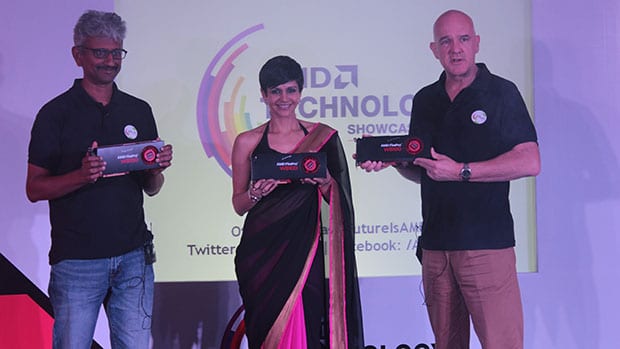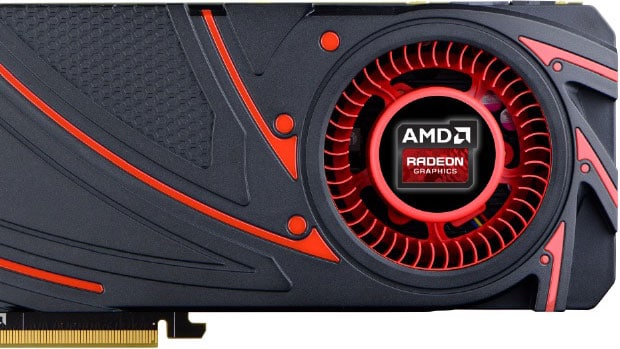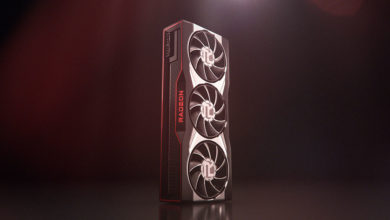Nvidia has had free reign over the consumer PC graphics market in India over the last few years, and it’s not like it was handed to it on a silver platter. The company has invested a lot of marketing funds and worked with developers to align itself with blockbuster games like Assassin’s Creed: Unity, Watch Dogs and Far Cry 4. In India too, it has been relentless in its efforts to woo PC gamers, with regular media launches and e-sports initiatives.
The approach of its rival, AMD, on the other hand, has been almost the opposite. It’s been making some impressive strides in the commercial sector in India, but its consumer strategy so far seems to have been to simply put products on store shelves and see what happens. But the events of the last few days have given us plenty of evidence to suggest that this is about to change.
 Mandira Bedi puts on her best “No idea what I’m doing here” smile, with AMD’s Raja Koduri and Richard Huddy.
Mandira Bedi puts on her best “No idea what I’m doing here” smile, with AMD’s Raja Koduri and Richard Huddy.
AMD hosted its Technology Showcase event last week, where it launched new workstation and consumer products in the presence of channel partners and the media. Speaking at a round-table with games journalists, Chandrahas Panigrahi, AMD India’s Director of Consumer and Mobility, didn’t shy away from recognising the good work done by his competitors.
Panigrahi is confident of eating into Nvidia’s share further and taking up the market leader position over the next three to four years.
“I compliment Nvidia. They have done a good job. They’ve set up this market for us by taking the first step forward,” conceded Panigrahi, but then moved to point out AMD’s strengths in the gaming segment. “In gaming, I feel that we have a few strategic advantages. First of all, there’s Mantle, a technology that improves game performance by 30-40 percent. Secondly, we have a wide portfolio of products available to customers. AMD has CPUs and GPUs, and we’ve also got Radeon memory and SSDs, which we haven’t launched in India yet, but we’re looking for ways to do that. Plus, there are now a lot of titles that are getting aligned with us, especially thanks to Mantle,” says Panigrahi.
AMD is particularly enthusiastic about the Mantle API that it says delivers a significant performance boost in games that take advantage of it. The company claims a 66 percent frame rate jump in Thief and a 41 percent boost in Battlefield 4, which are both games that leverage Mantle. The API is already supported by several game engines, including DICE’s Frostbite 3 and CryEngine 3.
According to AMD India, it currently accounts for 40 percent of the consumer graphics card segment in India, up from 25-30 percent last year. Panigrahi is confident of eating into Nvidia’s share further and taking up the market leader position over the next three to four years.
 AMD’s latest: The GCN-architecture-based Radeon R9 285 is out now in India, priced Rs 19,990.
AMD’s latest: The GCN-architecture-based Radeon R9 285 is out now in India, priced Rs 19,990.
He is similarly optimistic about gaming in India as a whole. “After a lull of about three years, gaming is going to take off again in India this year, and there are lots of contributors towards this. There are great titles coming out; parents are now more tolerant towards gaming and e-sports; and there are now a lot more people willing to look at gaming as a career.”
Significant hurdles remain, however, and Panigrahi says chief among them is the tendency of retailers to push entry-level graphics cards to inexperienced consumers who may have a need and the means for mid and high-end cards.
What AMD did with its Technology Showcase though was deliver a strong statement of intent and a clear commitment towards gaming.
“Retailers will actively push our entry level Radeon 5450 or the competition’s GT 210 even if the requirement is for an R7 or R9 card. Our R7 and R9 series take up 70 percent of the mid-to-high end segment, but this segment makes up just 28-30 percent of the overall market. It’s in the lower segment that Nvidia has larger market share. The entry level – cards priced between Rs 2,000 and Rs 2,500 – accounts for 75 percent of the market, but that’s not how it should be,” says Panigrahi.
AMD held its Technology Showcase just days after Nvidia launched its Maxwell-powered GTX 970 and GTX 980 GPUs in India, but this was no pissing contest. If anything, AMD launched the Radeon R9 285 at the event, which, at Rs 19,990, is pitted against the GTX 760. What AMD did at its Technology Showcase though was deliver a strong statement of intent and a clear commitment towards gaming. Along with Panigrahi, Raja Koduri, AMD’s Corporate Vice President of Visual Computing, and Richard Huddy, AMD’s Chief Gaming Scientist, were on hand to drive home the point – India’s consumer PC graphics market isn’t a one-horse race, and whatever way you look at it, that can only be good news for gamers.



